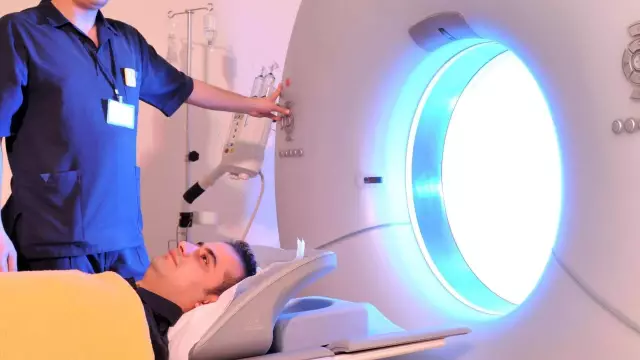- Author Rachel Wainwright [email protected].
- Public 2023-12-15 07:39.
- Last modified 2025-11-02 20:14.
Magnetic resonance imaging

The method of magnetic tomography is known under several names: magnetic resonance imaging, nuclear resonance, magnetic nuclear tomography. These names reflect the essence of the method: diagnostics based on the phenomenon of nuclear resonance, which occurs under the influence of a magnetic field. Despite such a terrifying name for people not associated with physics, this method has become a breakthrough in hardware diagnostics, and is currently considered the most informative method of medical imaging.
The procedure for magnetic tomography is as follows: the patient is placed in a prone position inside the box, where he, keeping immobility, is from 10 minutes to half an hour. The method is non-invasive, that is, there is no direct contact of the apparatus with the body, and therefore the person does not experience any unpleasant sensations, except that the sound from the operating apparatus may irritate him. In this case, the patient may be asked to wear headphones, but usually the sound is not strong enough to be a serious problem.
Using the method of magnetic tomography, it is possible to obtain an image of any internal environment of the body, and the image is layer-by-layer and very accurate, which makes it possible to reliably determine not only the size, but also the location, say, of a tumor or cyst, and its interaction with neighboring organs. Due to this, magnetic tomography is widely used in neurology, with its help most diseases of the brain and spinal cord are diagnosed.
In general, it should be said that the magnetic resonance method is so informative and safe that it can be used in almost all cases of diagnosing diseases of internal organs. Perhaps the only thing that hinders its even wider use than at present is the rather high cost of research, since the equipment for carrying it out is very expensive. However, now the question is "where to get a good MRI?" usually no longer worth it, since every large medical institution has such an opportunity.

Magnetic tomography is indispensable in the diagnosis of the following diseases:
- Suspected tumors of the brain and spinal cord;
- Malignant tumors of any internal organs, as well as all types of metastases (or suspicion of them) of malignant tumors;
- Stroke and post-stroke conditions;
- Head trauma;
- Spine injury;
- Vascular diseases of any origin, diagnostics of blood circulation in the affected area (magnetic resonance angiography);
- Inner ear diseases;
- Diseases of bones and joints.
A contraindication to magnetic tomography is the presence of implants - endoprostheses made of a material that can be magnetized. These can be auditory implants, artificial pacemakers, etc. In all other cases, contraindications are relative - that is, those that can be neglected in conditions of urgent need.
Found a mistake in the text? Select it and press Ctrl + Enter.


